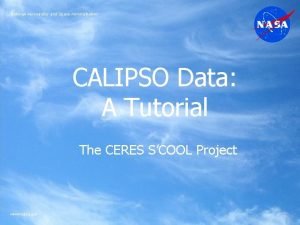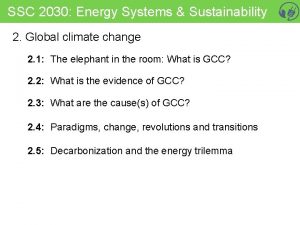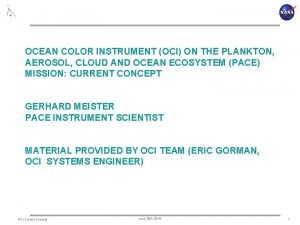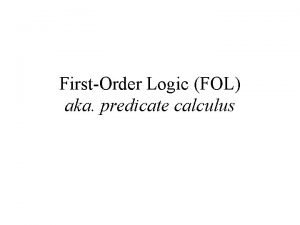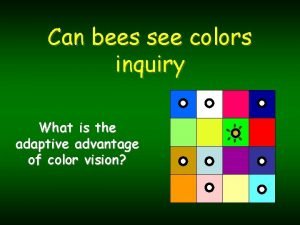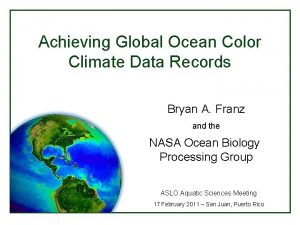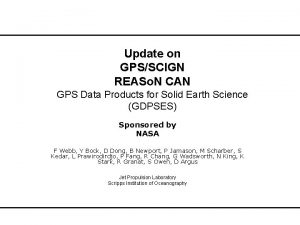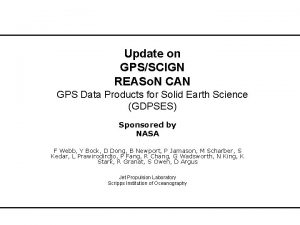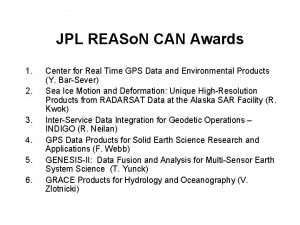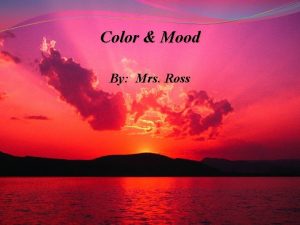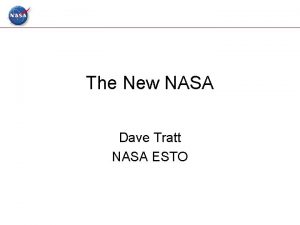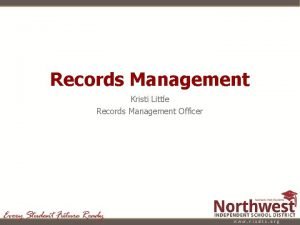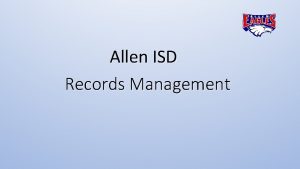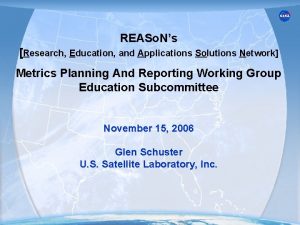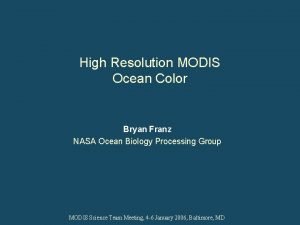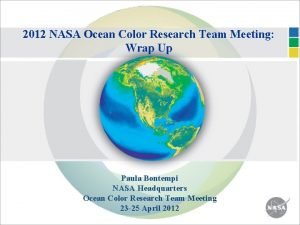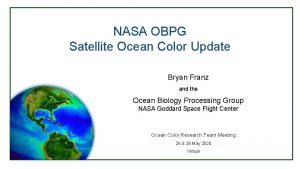Ocean Color Climate Records NASA REASo N CAN

























- Slides: 25

Ocean Color Climate Records NASA REASo. N CAN Watson Gregg NASA/GSFC/Global Modeling and Assimilation Office

Ocean Color Climate Records Global Mean Air Temperature: 0. 74 o increase 1906 -2005 (IPCC 2007) From Hansen et al. 2006, PNAS

SST: 0. 2 o. C increase 1980 -2003 (OISST) (from Rayner et al 192, JGR) Does ocean chlorophyll respond? Does ocean chlorophyll play a role?

Global Trend Analyses Gregg et al. (2005, GRL): 4% increase 1998 -2003 (P<0. 05) 10% increase on coasts (<200 m bottom depth) No change open ocean Behrenfeld et al. (2006, Nature): 0. 01 Tg integrated chl decrease per year 40 o. S to 40 o. N, 1999 -mid-2006 (P<0. 0001) No change poleward of 40 o Both used Sea. Wi. FS and matched changes to changes in other climate variables

Longer-Term Global Analyses Gregg and Conkright (2002, GRL): 6% decline 1980’s (CZCS) to 2000’s (Sea. Wi. FS) Entire CZCS record (1979 -1986), Sea. Wi. FS (1997 -2000) Open ocean only Antoine et al. (2005, JGR): 22% increase CZCS record (1979 -1983), Sea. Wi. FS (1998 -2002) Case 1 waters, open ocean only; Maximum 1. 5 mg m-3 Both used consistent algorithms for CZCS and Sea. Wi. FS

Using a single sensor (Sea. Wi. FS) trends can be reconciled between different approaches/investigators; trends are consistent with climate changes Changes determined from different sensors are not in agreement, despite consistent processing methodologies across sensors, but reconciliation is possible (confirmation is more difficult) MODIS-Aqua provides a test of the consistent processing/ consistent data assumption: coincident with Sea. Wi. FS

Global Annual Trends using Sea. Wi. FS, and Sea. Wi. FS/Aqua

Regional Annual Trends Sea. Wi. FS/Aqua Linear trends using 7 -year average/composite images were calculated, and when significant (P < 0. 05), shown here.

Maybe there is something different between Sea. Wi. FS and MODIS that is not corrected by consistent processing. Or maybe consistent processing is not enough.

Ocean Color Climate Records NASA REASo. N CAN Goal: Provide consistent, seamless time series of Level-3 ocean color data from 1979, with a 9 -year gap (1987 -1996) Produce Climate/Earth Science Data Records (CDR/ESDR) of ocean color Make CDR’s available to the public

CDR: A time series of sufficient length, consistency, and continuity to determine climate variability and change National Research Council, 2004 Technical Definition of Consistent/Seamless: all temporal sensor artifacts removed no obvious interannual discontinuities unattributable to natural variability all known mission-dependent biases removed or quantified similar data quality and structure

VIIRS-2 Ocean Color Satellite Missions: 1978 -2010 and Beyond VIIRS-NPP MODIS-Aqua MODIS-Terra OCTS/ POLDER CZCS Sea. Wi. FS “Missions to Measurements” 1980 1990 2000 2010

New and Post-Processing Enhancements Fine-tune radiance-chlorophyll relationships post-processing Correct for residual biases In situ data blending Integrate Models Aerosols Data assimilation All of the above

NASA Ocean Biogeochemical Model (NOBM) Dust (Fe) Sea Ice Winds, ozone, relative humidity, pressure, precip. water, clouds (cover, τc), aerosols (τa, ωa, asym) Winds SST Radiative Model (OASIM) Ed(λ) Es(λ) Biogeochemical Processes Model Outputs: IOP Layer Depths Temperature, Layer Depths Advection-diffusion Chlorophyll, Phytoplankton Groups Primary Production Nutrients DOC, DIC, p. CO 2 Spectral Irradiance/Radiance Ed(λ) Es(λ) Circulation Model (Poseidon) Global model grid: domain: 84 S to 72 N 1. 25 lon. , 2/3 lat. 14 layers

Model vs. Sea. Wi. FS: Bias = +5. 5% Uncertainty = 10. 1%


Advantages of Data Assimilation Achieves desired consistency, with low bias Responds properly to climatic influences Full daily coverage – no sampling error Effective use of data to keep model on track Only spatial variability required from sensors Disadvantages of Data Assimilation Low resolution (for now) No coasts (for now) Excessive reliance on model biases Cannot validate model trends with sensor data

Compared to In situ Data Sea. Wi. FS Free-run Model Assimilation Model Bias -1. 3% -1. 4% 0. 1% Uncertainty 32. 7% 61. 8% 33. 4% N 2086 4465

Can the CZCS provide a Climate Data Record? CDR: A time series of sufficient length, consistency, and continuity to determine climate variability and change National Research Council, 2004 CZCS (from Gregg and Conkright, 2002 GRL)

Temperature Anomaly (o. C) 0. 6 0. 4 Sea. Wi. FS 0. 2 0. 0 CZCS -0. 2 1970 1980 1990 2000

CZCS Deficiencies 1) Low SNR Solution: Take mean over 25 km 2) 5 bands, only 4 of which quantitatively useful -- limits aerosol detection capability Solution: Innovative approaches for aerosols 3) Navigation Solution: Bias corrected, orbit vectors obtained, reconstructing viewing angles 4) El Chichon Solution: Tighter restriction on reflectance 5) Anomalous behavior post-1981 Solution: Don’t use Band 2 6) Sampling

CZCS Sampling

Ship observations per decade: light symbol=10, medium=100, dark=400 from Rayner etal 1993, JGR

Ocean Color Climate Records Distinct from Operations Data Sets managed by OGBP Stored at GES-DAAC, access using Giovanni L 3 format, 25 -km, monthly, consistent with other climate data sets Includes discontinuous time series 1978 -1986; 1996 -2005 chlorophyll only for now mission names not mentioned except under detailed information Facilitates new and post-processing advances to ensure CDR consistency Does not interfere with operations requirements and community

Climate Records Issues 1) How calibrate historical and future sensors, maintaining consistency? 2) Is BRDF a good idea? 3) Can we define more rigorous metrics than in situ comparisons, that constrain global mean estimates? 4) Is it acceptable to have two data streams: operational (best available methods; mission-dependent, high resolution) climate (maximum commonality/consistency of methods, low resolution)? 5) How much consistency can we achieve without resorting to postprocessing methods (blending of in situ data, assimilation)?
 Ito namang pinsan ko saka lang kikilos pag pinapalo ko
Ito namang pinsan ko saka lang kikilos pag pinapalo ko Nasa www.nasa.gov
Nasa www.nasa.gov Nasa center for climate simulation
Nasa center for climate simulation Https://climate.nasa.gov/evidence/
Https://climate.nasa.gov/evidence/ Climate change 2014 mitigation of climate change
Climate change 2014 mitigation of climate change Brainpop ocean currents
Brainpop ocean currents Ocean atmosphere and climate
Ocean atmosphere and climate Ocean atmosphere and climate
Ocean atmosphere and climate Types of divergent plate boundary
Types of divergent plate boundary Ocean ocean convergent boundary
Ocean ocean convergent boundary Convergent plate boundaries
Convergent plate boundaries Ocean ocean convergent boundary
Ocean ocean convergent boundary Chapter 15 ocean water and ocean life wordwise answer key
Chapter 15 ocean water and ocean life wordwise answer key Ice age crack
Ice age crack Ocean to ocean convergent boundary
Ocean to ocean convergent boundary Red ocean blue ocean strategi
Red ocean blue ocean strategi Ocean color instrument
Ocean color instrument Line value shape form space texture and color
Line value shape form space texture and color Visual elements color
Visual elements color Forward chaining
Forward chaining Is employing tricks to add some magic to the presentation
Is employing tricks to add some magic to the presentation Can triplets have different hair color
Can triplets have different hair color What colors can bees see
What colors can bees see If you can imagine it you can achieve it
If you can imagine it you can achieve it Kinds of comparison
Kinds of comparison If you think you can you can poem
If you think you can you can poem

